
Freyburg is a town in the Burgenlandkreis district, in Saxony-Anhalt, Germany. It is situated on the river Unstrut, 9 km northwest of Hanseatic Naumburg, 63 km from Leipzig and 231 km from Berlin. It is part of the Verwaltungsgemeinschaft Unstruttal. On 1 July 2009 it absorbed the former municipalities Pödelist, Schleberoda, Weischütz and Zeuchfeld. Freyburg consists of the Ortsteile (divisions) Dobichau, Freyburg, Nißmitz, Pödelist, Schleberoda, Weischütz, Zeuchfeld and Zscheiplitz.

Salem Abbey was a very prominent Cistercian monastery in Salem in the district of Bodensee about ten miles from Konstanz, Baden-Württemberg, Germany. The buildings are now owned by the State of Baden-Württemberg and are open for tours as the Salem Monastery and Palace.
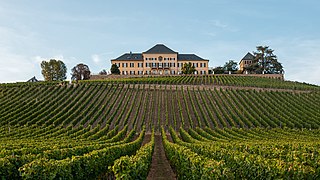
Schloss Johannisberg is a castle and winery in the village of Johannisberg to the west of Wiesbaden, Hesse, in the Rheingau wine-growing region of Germany. It has been making wine for over 900 years. The winery is most noted for its claim to have "discovered" late harvest wine. The palace is a venue of the Rheingau Musik Festival, made available by co-founder Tatiana von Metternich-Winneburg.

Weikersheim Palace is a palace in Weikersheim, Baden-Württemberg, Germany. It was a medieval seat and later a Renaissance residence of the princely House of Hohenlohe.

Trumau is a town in the district of Baden in Lower Austria in Austria.

Stolzenfels Castle is a former medieval fortress castle ("Burg") turned into a palace, near Koblenz on the left bank of the Rhine, in the state of Rhineland-Palatinate, Germany. Stolzenfels was a ruined 13th-century castle, gifted to the Prussian Crownprince, Frederick William in 1823. He had it rebuilt as a 19th-century palace in Gothic Revival style. Today, it is part of the UNESCO World Heritage Site Upper Middle Rhine Valley.
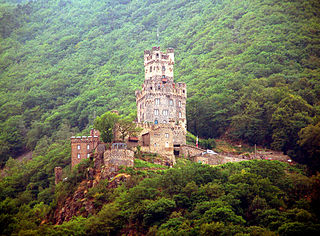
Sooneck Castle is a castle in the upper middle valley of the Rhine, in the Mainz-Bingen district of Rhineland-Palatinate, Germany. It is located near the village of Niederheimbach between Bingen and Bacharach.
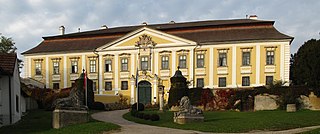
Schloss Gobelsburg is a winery and castle in the Kamptal wine growing region in Lower Austria, some 50 miles to the north west of Vienna. The estate produces both red and white wines. Wine production on the estate dates to 1171; it is the oldest winery in the Danube region. The structure is a listed building.

Calenberg Castle was a medieval lowland castle in central Germany, near Schulenburg in the borough of Pattensen, 13 km west of the city of Hildesheim. It was built as a water castle in 1292 by the Welf duke, Otto the Strict, in der Leine river meadows between 2 branches of the Leine river on the southern part of the chalk marl hill of the Calenberg. At the start of the 16th century it was converted into a fort (Feste). In the 15th century, Fort Calenberg gave its name to the Welf Principality of Calenberg. Following the Thirty Years' War it lost its military importance and was slighted. Today it is a ruin with underground vaults that are surrounded by high ramparts.

Aesch Castle or Blarer Castle is a castle in the Swiss municipality of Aesch in the canton of Basel-Country.
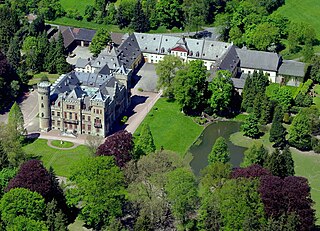
Herdringen Castle is a castle in the Ortsteil Herdringen of the town of Arnsberg, Germany. It is the seat of the Fürstenberg-Herdringen family and the present building is one of the most notable secular Gothic revival buildings in Westphalia.

Schloss Heiligenberg is a castle to the east of Jugenheim, part of Seeheim-Jugenheim, about 12 kilometres to the south of Darmstadt, Germany. It is built on the Heiligenberg, with panoramic views of the Rhineland as far as the Palatinate. It is now the headquarters of the Amt für Lehrerbildung, though its 'Gartensaal' is occasionally used for concerts and art exhibitions.

The Marburger Schloss, also known as Landgrafenschloss Marburg, is a castle in Marburg, Hesse, Germany, located on top of Schlossberg. Built in the 11th century as a fort, it became the first residence of Landgraviate of Hesse (HRE). The Marburg Colloquy was held here in 1529.
Schaudichnichtum Lodge was a former hunting lodge southwest of the town of Bad Dürkheim in the German state of Rhineland-Palatinate. Like its near neighbours, Kehrdichannichts, Murrmirnichtviel and Jägerthal, it was used as accommodation for the nobility of the Electoral Palatinate during the 18th century when they went hunting in the Palatine Forest.

Lindheim Castle is a former medieval castle in Lindheim, in the municipality of Altenstadt, Wetteraukreis county, in the German state of Hesse. In the Middle Ages the castle became a large joint inheritance or Ganerbschaft of lesser noble families, who were an important local power in the eastern Wetterau. In 1697, stately home, Schloss Lindheim, was built. Only a few remnants of both buildings have survived today.

Scherenburg Castle is a ruined hill castle at an elevation of 200 m above sea level (NN) which stands on a hillside above the town of Gemünden am Main in the province of Lower Franconia in the German state of Bavaria.

Greifenstein Castle lies in the eponymous village of Greifenstein in the county of Lahn-Dill-Kreis in Middle Hesse, Germany. It is a geo point in the national geopark of Westerwald-Lahn-Taunus.

Schloss Schöneck is a castle which stands on a rock outcrop in the Ehrbach Gorge in the borough of Boppard in the Hunsrück mountains of Germany.

Zwingenberg Castle, also called Zwingenberg or Schloss Zwingenberg, stands on the right bank of the River Neckar where it cuts through the Odenwald hills in central Germany. The castle is located in the municipality of Zwingenberg in the state of Baden-Württemberg.
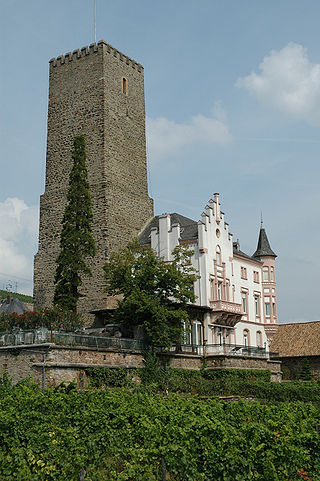
The Boosenburg is a lowland castle in Rüdesheim am Rhein, Rheingau-Taunus-Kreis, Hesse, Germany, located in the Rhine valley and dating back to the 12th century. It is locally known as Oberburg in relation to the near and slightly lower Brömserburg. It has been part of the Rhine Gorge World Heritage Site from 2002.



















